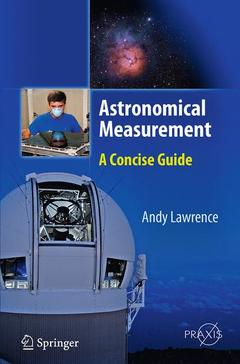Description
Astronomical Measurement, 2014
A Concise Guide
Astronomy and Planetary Sciences Series
Author: Lawrence Andy
Language: English
Subject for Astronomical Measurement:
Keywords
Astronomical detectors; Astronomical imaging; Astronomical interferometry; Astronomical optics; Astronomical spectroscopy; Atmospheric distortion; Detection of light; Introduction to Astronomical measurement; Light polarisation; Signal to noise; Space telescopes; Spectroscopy in astrophysics; Statistics in astronomy; Telescope design
Publication date: 08-2016
Support: Print on demand
Publication date: 12-2013
192 p. · 15.5x23.5 cm · Hardback
Description
/li>Contents
/li>Biography
/li>Comment
/li>
The book is based on a short self contained lecture course for advanced undergraduate students developed and taught by the author over several years.
Preface.- Acknowledgements.- Signal, Distortion, and Noise.- The atmosphere and how to avoid it.- Mapping the Sky.- Detection of Light.- Spectroscopy.- Overview of Statistics.- Basic orbital mechanics.- References.- Glossary.- Solutions.- Index.
Provides a concise introduction to the physical principles of astronomical measurement - spacecraft, telescopes, detectors, the atmosphere, spectroscopy, and the basics of measured quantities and statistics
Takes a new approach on teaching astronomical measurement following the chain of measurement through atmosphere, imaging, detection, spectroscopy, timing, and hypothesis testing
Covers all wavelengths – radio, infrared, optical, UV, X-ray, gamma-ray
Concentrates on key principles rather than details
Each chapter concludes with a set of exercises. Solutions provided.



